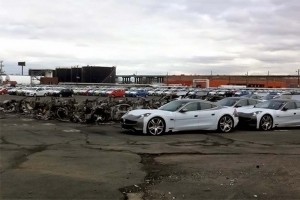
More than 320 Fisker Karmas were lost at this NJ port, including over a dozen that burned when saltwater shorted their batteries.
A handful of images underscore the devastation caused by Superstorm Sandy: collapsed homes on Staten Island, a ruined roller coaster on the Seaside Heights, NH boardwalk now sitting in the ocean waves – and cars floating out of flooded Manhattan garages.
A preliminary estimate by the National Automobile Dealers Association suggests that as many as 200,000 vehicles may have been damaged by the storm, though that figure could run higher as insurance adjusters and other experts tally things up.
While it is possible that some of those vehicles will be salvageable, a disproportionate number will likely have to be scrapped, however, due to not only the immediate damages but potential for long-term problems with vehicles that have been immersed in saltwater.
“We had nearly 5,000 cars at Port Elizabeth, New Jersey and a little over 1,000 more cars in dealer stock up and down the East Coast that are un-saleable and must be destroyed,” says Dave Reuter, chief U.S. spokesman for Nissan. “Obviously there are customer cars that were damaged, too, but it will take time to determine how many.”
Other automakers experienced similar problems likely to result in the scrapping of tens of thousands of vehicles at East Coast dealer showrooms or still sitting in ports, like the one in North Jersey. There are more than 1,500 new car dealers in the populous New York tri-state areas which was hardest hit by Sandy.
More than a dozen Fisker Karma plug-in hybrids and at least one Toyota Prius hybrid caught fire during the flooding, a problem now believed to have been caused by saltwater shorting out the vehicles’ batteries. Fisker reports about 320 of its new model were lost due to the flooding, all told, at Port Elizabeth.
Another 4,000 Toyota and Lexus models were also at the shipping center just outside Newark, waiting for delivery to dealers.
Just a few miles north, a storage lot contains several 100 taxis caught in deep floodwaters and likely to need being replaced.
Experts say some vehicles can be salvaged, though usually only those that saw water rise no higher than around the middle of the tires. Much above that and water likely has penetrated into critical mechanical components, including the engine and electronic controls, as well as into insulation and other foam materials that can be difficult, if not impossible, to dry and then restore to pristine condition.
The process of inspecting and then replacing vehicles at dealer showrooms could be slow, NADA senior analyst Larry Dixon told the Bloomberg News Service in an interview, “”We don’t see replacement demand starting to accelerate until we’re into December.”
The vast majority of the damage caught vehicles already in the field, however, whether commercial cars, trucks or taxis – like the fleet in Hoboken. The current focus of first-responders is on clearing wreckage off roads, helping make damaged facilities habitable and ensuring those people caught in the storm have food, water and shelter. It could be weeks, even months, before the damage to all the vehicles caught by Superstorm Sandy can be fully assessed – and owners covered by insurance can seek out replacement vehicles.
The massive disaster was believed to have seriously impacted new vehicle sales during the final days of October, Nissan estimating it’s slight 0.5% decline for the month was largely the result of Sandy’s impact.
But industry analysts see a more positive future once those estimated 200,000 vehicles start to be replaced. “One would expect” strong demand for new vehicles in the months ahead, according to Nissan’s Reuter.
In addition, the push to rebuild, especially in the tri-state New York area, could create something of a boom in sales of pickups and vans to contractors, forecast Ricky Beggs, managing editor of the Black Book, a vehicle price tracking service, “because there’ll be demand for services to repair the damages from the storm, so someone who might have had one truck may now need two.”
But Beggs also warns that the sales bubble likely to follow in the weeks ahead could lead to increase prices, as well, forecasting used vehicles could see an increase of anywhere from $200 to $600 each. And the used car market was already nudging record prices even before the natural disaster.
(Experts warn to be wary after Superstorm Sandy because scam artists may try to pass off storm-ruined cars to unsuspecting used car buyers. Click Here for that story.)
